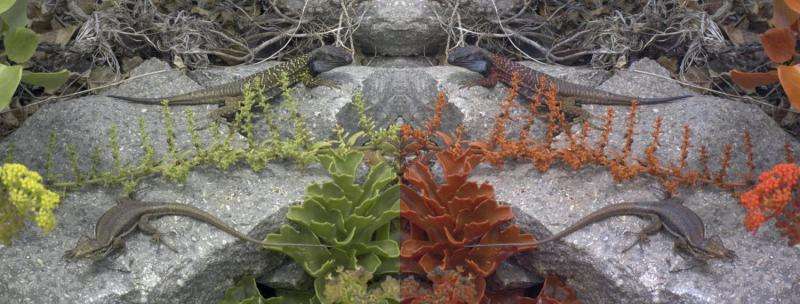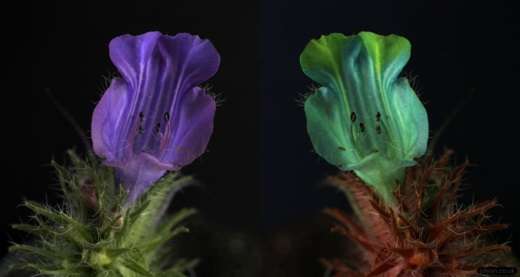Animal-eye view of the world revealed with new visual software

New camera technology that reveals the world through the eyes of animals has been developed by University of Exeter researchers. The details are published today in the journal Methods in Ecology and Evolution.
The software, which converts digital photos to animal vision, can be used to analyse colours and patterns and is particularly useful for the study of animal and plant signalling, camouflage and animal predation, but could also prove useful for anyone wanting to measure colours accurately and objectively.
The software has already been used by the Sensory Ecology group in a wide range of studies, such as colour change in green shore crabs, tracking human female face colour changes through the ovulation cycle, and determining the aspects of camouflage that protect nightjar clutches from being spotted by potential predators.
Jolyon Troscianko from the Centre for Ecology and Conservation at the University of Exeter said: "Viewing the world through the eyes of another animal has now become much easier thanks to our new software.
"Digital cameras are powerful tools for measuring colours and patterns in nature but until now it has been surprisingly difficult to use digital photos to make accurate and reliable measurements of colour. Our software allows us to calibrate images and convert them to animal vision, so that we can measure how the scene might look to humans and non-humans alike.

"We hope that other scientists will use this open access software to help with their digital image analysis."
Until now, there has been no user-friendly software programme that enables researchers to calibrate their images, incorporate multiple layers - visible and UV channels -, convert to animal colour spaces, and to measure images easily. Instead, researchers have needed to do much of this manually, including the sometimes complex programming and calculations involved. This freely available open source software now offers a user-friendly solution.
Colour vision varies substantially across the animal kingdom, and can even vary within a given species. Most humans and old-world monkeys have eyes sensitive to three colours; red, green and blue, which is more than other mammals that are only sensitive to blue and yellow. It is impossible for humans to imagine seeing the world in more than three primary colours, but this is common in most birds, reptiles, amphibians and many insects that see in four or more. Many of them can also see into the ultraviolet range, a world completely invisible to us without the use of full spectrum cameras. So scientists studying these species need to measure UV to understand how these animals view the world.
Using a camera converted to full spectrum sensitivity, one photograph taken through a visible-pass filter can be combined by the software with a second taken through an ultraviolet-pass filter. The software can then generate functions to show the image through an animal's eyes.
The researchers have provided specific data on camera settings for commonly studied animals, such as humans, blue tits, peafowl, honey bees, ferrets and some fish.
Flowers often look particularly striking in UV because they are signalling to attract pollinators that can see in UV, such as bees. UV is also often important for birds, reptiles and insects in their colourful sexual displays to attract mates.
The software is free to download and is available here.
Image Calibration and Analysis Toolbox - a free software suite for measuring reflectance, colour, and pattern objectively and to animal vision by Jolyon Troscianko & Martin Stevens is published in Methods in Ecology & Evolution.
Journal information: Methods in Ecology and Evolution
Provided by University of Exeter





















